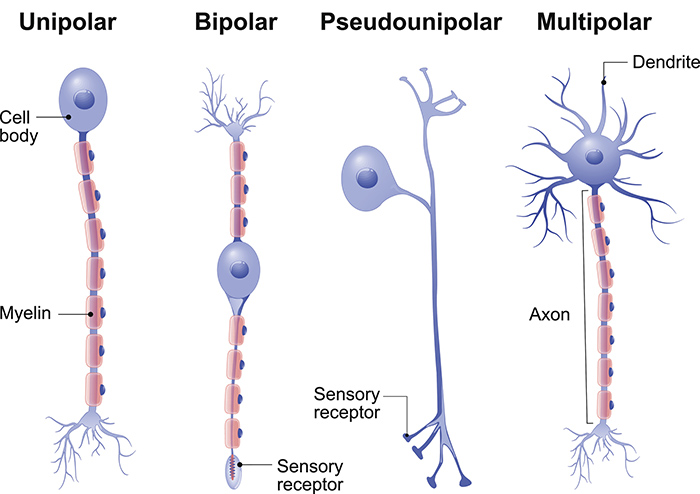Types of neurons

Image credit: iStockphoto
Neurons are the cells that make up the brain and the nervous system. They are the fundamental units that send and receive signals which allow us to move our muscles, feel the external world, think, form memories and much more.
Just from looking down a microscope, however, it becomes very clear that not all neurons are the same. So just how many types of neurons are there? And how do scientists decide on the categories? For neurons in the brain, at least, this isn’t an easy question to answer. For the spinal cord though, we can say that there are three types of neurons: sensory, motor, and interneurons.
Sensory neurons
Sensory neurons are the nerve cells that are activated by sensory input from the environment - for example, when you touch a hot surface with your fingertips, the sensory neurons will be the ones firing and sending off signals to the rest of the nervous system about the information they have received.
The inputs that activate sensory neurons can be physical or chemical, corresponding to all five of our senses. Thus, a physical input can be things like sound, touch, heat, or light. A chemical input comes from taste or smell, which neurons then send to the brain.
Most sensory neurons are pseudounipolar, which means they only have one axon which is split into two branches.
Motor neurons
Motor neurons of the spinal cord are part of the central nervous system (CNS) and connect to muscles, glands and organs throughout the body. These neurons transmit impulses from the spinal cord to skeletal and smooth muscles (such as those in your stomach), and so directly control all of our muscle movements. There are in fact two types of motor neurons: those that travel from spinal cord to muscle are called lower motor neurons, whereas those that travel between the brain and spinal cord are called upper motor neurons.
Motor neurons have the most common type of ‘body plan’ for a nerve cell - they are multipolar, each with one axon and several dendrites.
Interneurons
As the name suggests, interneurons are the ones in between - they connect spinal motor and sensory neurons. As well as transferring signals between sensory and motor neurons, interneurons can also communicate with each other, forming circuits of various complexity. They are multipolar, just like motor neurons.
Neurons in the brain
In the brain, the distinction between types of neurons is much more complex. Whereas in the spinal cord we could easily distinguish neurons based on their function, that isn’t the case in the brain. Certainly, there are brain neurons involved in sensory processing – like those in visual or auditory cortex – and others involved in motor processing – like those in the cerebellum or motor cortex.
However, within any of these sensory or motor regions, there are tens or even hundreds of different types of neurons. In fact, researchers are still trying to devise a way to neatly classify the huge variety of neurons that exist in the brain.
Looking at which neurotransmitter a neuron uses is one way that could be a useful for classifying neurons.
However, within categories we can find further distinctions. Some GABA neurons, for example, send their axon mostly to the cell bodies of other neurons; others prefer to target the dendrites. Furthermore, these different neurons have different electrical properties, different shapes, different genes expressed, different projection patterns and receive different inputs. In other words, a particular combination of features is one way of defining a neuron type.
The thought is that a single neuron type should perform the same function, or suite of functions, within the brain. Scientists would consider where the neuron projects to, what it connects with and what input it receives.
This is really the purpose of trying to classify neurons: in the same way as we can say that spinal cord sensory neurons bring sensory input from the periphery to the central nervous system, we would like to be able to say that the role of ‘neuron X’ in the hippocampus is to (for example) let you distinguish between similar but slightly different memories.
So the answer to the question ‘What types of neurons are there?’ isn’t something we can fully answer yet. In the spinal cord, it is pretty simple. But part of what gives the brain its complexity is the huge number of specialised neuron types. Researchers are still trying to agree on what these are, and how they should be classified. Once we can do that, we’ll be in a good position to delve even deeper into how the brain operates.
